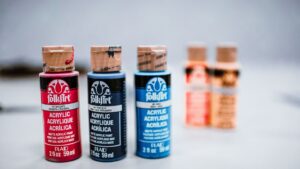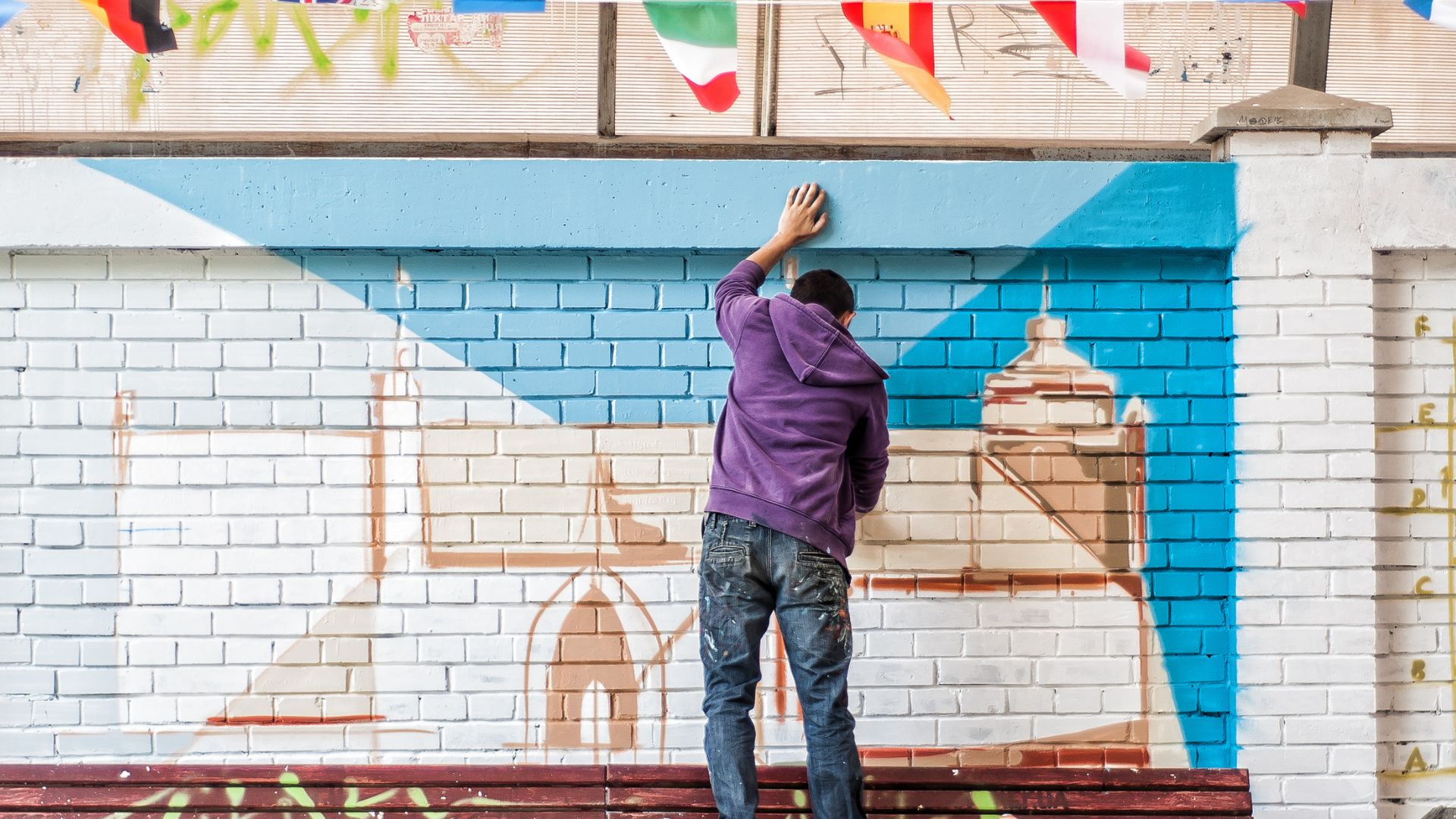You can use acrylic paint for an outdoor mural! Acrylic paints are a fantastic choice for outdoor projects because they’re durable, weather-resistant, and offer a vibrant color range. Let’s dive deeper into the ins and outs of using acrylics for your outdoor masterpiece.
Why Acrylic Paint Works Well for Outdoor Murals
Acrylic paints are water-based, which means they dry quickly and form a tough, flexible layer that can withstand various weather conditions. They’re also fade-resistant and retain their color vibrancy for a long time, making them perfect for outdoor settings.
Choosing the Right Acrylic Paint
When selecting acrylic paint for your mural, opt for high-quality, outdoor-grade acrylics. These paints are specifically formulated to endure outdoor elements like sun exposure, rain, and temperature changes. Look for brands that mention their suitability for exterior use on their labels.
Preparing the Surface
Proper surface preparation is key to a successful mural. Ensure the wall or surface is clean, dry, and primed before painting. Use a primer suitable for outdoor painting to create a smooth base for the acrylic paint to adhere to.
Techniques for Longevity
To ensure the longevity of your mural, consider applying a protective sealant or varnish once the painting is complete. This additional layer helps safeguard the artwork from UV rays and other environmental factors, extending its lifespan.

Tips for Painting
- Layering: Start with lighter colors and gradually build up to darker shades. This layering technique adds depth and dimension to your mural.
- Weather Consideration: Check the weather forecast before painting. Avoid extremely hot, cold, or humid days, as extreme conditions can affect the paint’s drying process.
- Test Colors: Test your chosen colors on a small area of the wall to ensure they appear as expected and complement the surroundings.
Maintenance and Care
Regular maintenance can help preserve your outdoor mural. Periodically inspect the artwork for any signs of wear or damage, and consider touch-ups or resealing if needed to keep it looking vibrant.
External Resources for Further Guidance
For more detailed guidance on outdoor mural painting techniques, check out these resources:
- Mural Techniques: Outdoor Acrylic Painting Tips by Artists Network
- Creating an Outdoor Mural by Golden Paints
- Tips for Painting Murals Outdoors by Liquitex
Remember, with the right materials, preparation, and care, your acrylic outdoor mural can be a stunning and long-lasting addition to any space.
Embracing Creativity Outdoors
Outdoor murals hold immense potential to transform spaces, tell stories, and engage communities. When working on your mural, consider these additional tips to elevate your artistic endeavor:
1. Engage with the Environment
Incorporate Surroundings: Take inspiration from the environment around the mural site. Integrate elements like trees, architectural features, or natural landscapes into your design. This not only adds character but also fosters a connection between the artwork and its surroundings.
2. Collaborate and Communicate
Community Involvement: Consider involving the local community or volunteers in the mural project. Collaboration can foster a sense of ownership and pride, creating a shared space cherished by all.
3. Plan and Sketch
Sketch and Visualize: Before starting the mural, sketch your ideas on paper or digitally. Visualizing the layout, colors, and composition helps refine your concept and ensures a smooth painting process.
4. Maintenance Matters
Regular Check-ups: Schedule routine inspections to check for any wear or damage to the mural. Promptly address any issues to maintain the artwork’s integrity and vibrancy.
5. Seek Inspiration and Guidance
Learn from Others: Explore other outdoor murals in your area or globally. Observing different styles and techniques can inspire new ideas and approaches for your own project.
Conclusion
Acrylic paint is an excellent choice for outdoor murals, offering durability, vibrant colors, and versatility. Remember to use high-quality, outdoor-grade acrylics, prepare the surface properly, and consider applying a protective sealant for long-lasting results.
By embracing creativity, community engagement, and proper maintenance, your outdoor mural can become a captivating and enduring piece of art, enriching the outdoor spaces it graces.
Comparison tabular
Here’s a comparison table detailing some essential aspects of each type:
| Aspect | Acrylic Paint | Oil-Based Paint | Latex Paint |
|---|---|---|---|
| Drying Time | Quick drying; typically within minutes/hours | Slower drying time; takes days to cure | Quick drying; dries faster than oil paint |
| Durability | Durable; resistant to weather conditions | Highly durable; withstands harsh elements | Durable; good resistance to weather |
| Flexibility | Flexible and less prone to cracking | Flexible but can become brittle over time | Flexible and less prone to cracking |
| Color Vibrancy | Retains color vibrancy over time | Rich color pigments; can yellow over time | Maintains color; less likely to yellow |
| Surface Adhesion | Bonds well to various surfaces | Excellent adhesion to surfaces | Good adhesion to surfaces |
| Environmental Impact | Low VOC content | High VOC content; emits strong odor | Low VOC content; emits mild odor |
| Cleanup | Water-based; easy cleanup | Requires solvents for cleanup | Water-based; easy cleanup |
This table provides a snapshot of the key differences between these paint types, helping you make an informed decision based on drying time, durability, flexibility, color retention, environmental impact, and ease of cleanup.
Wrapping up
Choosing the right paint for your outdoor mural is crucial for its longevity and vibrancy. Acrylic paint stands out as a fantastic choice due to its quick drying time, durability against varying weather conditions, and ability to retain vibrant colors over time. Its water-based nature also makes cleanup hassle-free.
While oil-based paint offers exceptional durability, it tends to dry slowly and emits strong odors due to its high VOC content. Latex paint, on the other hand, dries quickly like acrylic paint but doesn’t hold up as well against harsh elements compared to acrylic.
Ultimately, your choice depends on various factors: the specific requirements of your mural, environmental considerations, and your preferences in terms of application, cleanup, and long-term maintenance.
Remember, proper surface preparation, using high-quality materials, and considering a protective sealant can significantly impact the lifespan and appearance of your mural.
So, whether you’re adding a splash of color to a community wall, transforming an outdoor space, or expressing your creativity in a public area, the versatility and durability of acrylic paint make it a fantastic choice for your outdoor mural project.
Now, armed with this information, let your creativity flow and bring your outdoor mural to life, adding beauty and vibrancy to your surroundings for years to come.

For over a decade, I’ve been Mike, an artist, crafter, and designer deeply immersed in the Croc world. I thrive on crafting unique, size-inclusive patterns, fostering creativity, and sharing them on ktforum.com. My designs aim to ignite your creative spark and delight you, ensuring clarity and ease of use through rigorous testing. Join me in expressing your creative flair and showcasing your craft with joy.
Related Posts
- The Best Time of Day for Painting an Outdoor Mural
When it comes to painting an outdoor mural, choosing the right time of day can…
- Choosing the Right Paint for Outdoor Canvas Art: What You Need to Know
When it comes to creating stunning art for the outdoors, one of the key considerations…
- Can You use spray paint for the mural
Using spray paint for a mural can be an exciting and dynamic way to create…
- The Ideal Weather Conditions for Painting an Outdoor Mural
Creating an outdoor mural is an exciting project that adds vibrancy and personality to a…

